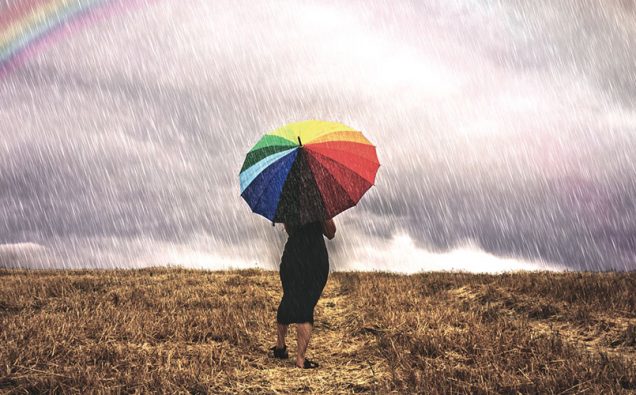
A woman with an umbrella walks under the rain in a field, in the background there is a rainbow. photo WMO
It was in the midst of Britain’s industrial revolution in the early 19th century that William Wordsworth, the worshiper of Nature wrote: “Getting and spending we lay waster our powers, Little we see in Nature that is ours.”
Today, more than two centuries later, human beings remain too occupied with necessities of life to pause and pay heed to Nature’s Earth-shaking calls.
That remains the case despite a growing awareness about the climatic disasters in the making and the several jolts in the form of extreme weather –the hottest months on record since late 2015, frequent Tsunamis, temblors, flooding, droughts, smogs, environmental pollution and precarious melting of the Arctic ice.
It is alarming how despite scientific evidence a large number of people still deny the link between climate change and human activity. Except some bigger picture decisions and the Paris Climate Accord, nations have not done enough to save the planet.
So this year’s Mother Earth Day must be seen as a warning and a celebration.
According to the United Nations, the International Mother Earth Day should remind everyone that the Earth and its ecosystems provide us with life and sustenance and also recognize a collective responsibility, as called for in the landmark 1992 Rio Declaration on Environment and Development, to promote harmony with nature and the Earth to achieve a just balance among the economic, social and environmental needs of present and future generations of humanity.
But sharing the planet demands much more than just talking the talk. The world population is growing, demand for development is expanding, resources are shrinking and governments have not shown the kind of leadership that could ensure sustainable future for us.
One key pillar for successful movement to change our harmful policies, in disregard of climatic signs, should be building up environmental and climate literacy.
This literacy, the UN believes, is the engine not only for creating green voters and advancing environmental and climate laws and policies but also for accelerating green technologies and jobs.
The theme for 2017 is ‘Environmental and Climate Literacy.’ Education is the foundation for progress. A global citizenry must be built that is fluent in the concepts of climate change and aware of its unprecedented threat to our planet.
The bottom line: “Everyone must be empowered with the knowledge to inspire action in defense of environmental protection,” as the world body stresses.

















